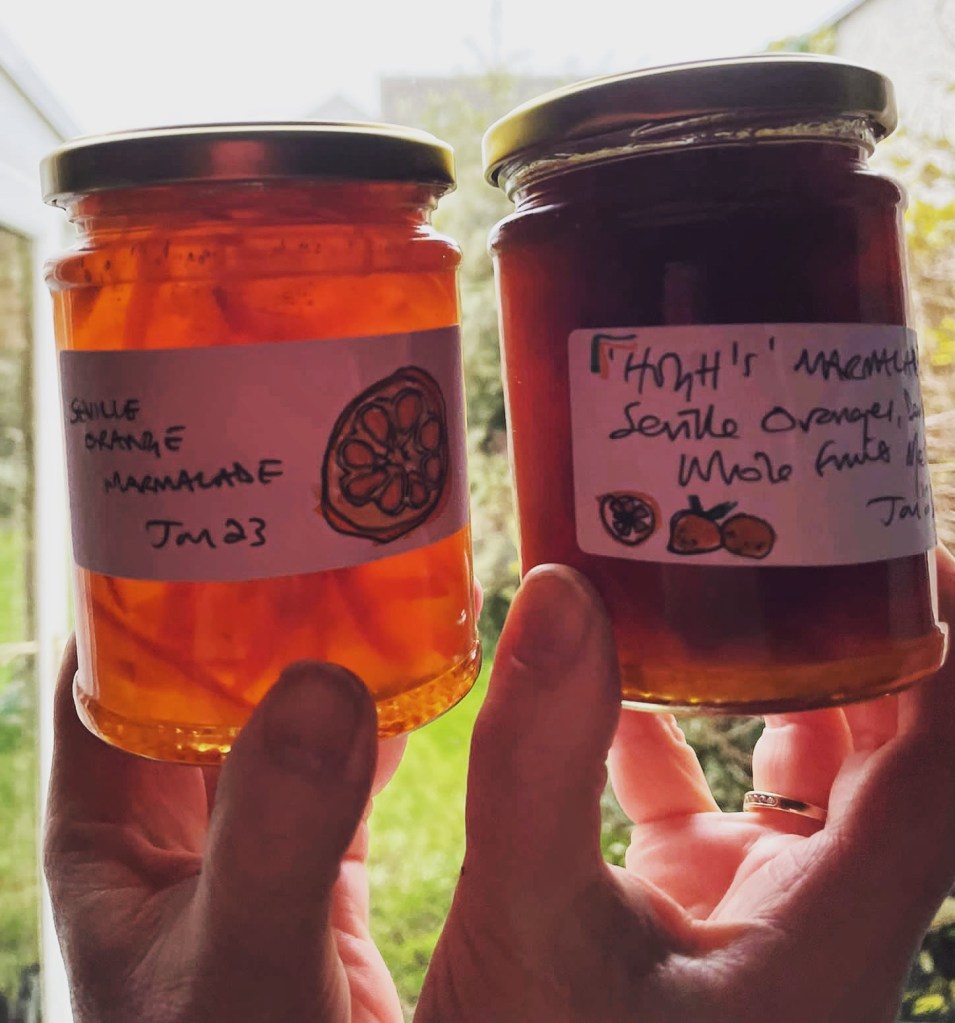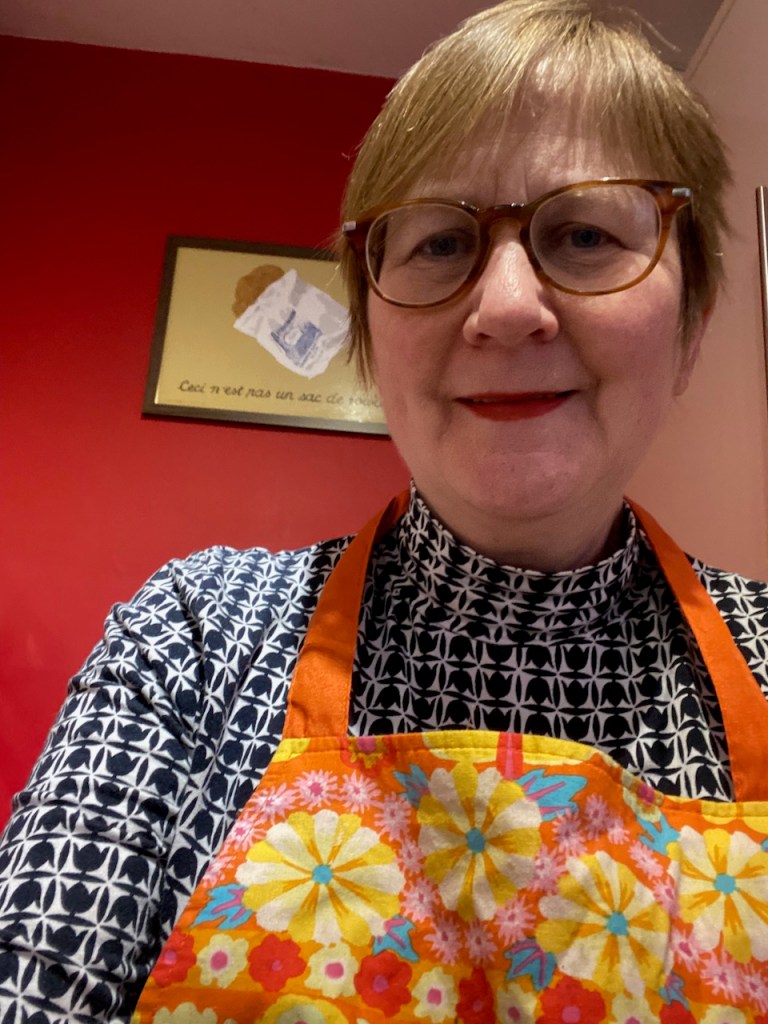
After the sparkle and joy of December, January can be a bit of a drag. Edinburgh is a lovely city but January is still winter and daylight is in short supply. Added to that, my self-imposed New Year quest for health improvement and renewal can, all told, make it a month to endure or thole * rather than relish.

Enter marmalade making and its orange radiance to bring some sunshine.

January is traditionally marmalade month coinciding with the arrival from Spain of the bitter Seville oranges that make the best marmalade. You can make marmalade all year round using tins of pre-prepared fruit, or as I optimistically planned last year, by freezing the time-limited Seville oranges to use at a later date. But it’s the arrival of the fresh fruit from Spain into a grey January that really starts the buzz amongst marmalade aficionados.
When I first started marmalade making a few years back – my attempts could best be described as inconsistent. The end result usually tasted ok but often did not set ( marmalade sauce anyone ? ), and when it did set, the peel all stayed at the top and did not have the desired even peel distribution. So during Covid times, when others were mastering new languages or learning to crochet a blanket, I made it my mission to crack the marmalade code and achieve preserve perfection.
I bought several books on the subject (including unintentionally, one written in French), and a special thermometer to check for a set, and continued making marmalade and other jams with mixed results. Although the taste was usually good – it was hit or miss when it came to setting and achieving the right consistency still proved elusive.
Success only came when I was given some very useful advice from an expert preserves maker, Jaki at Perfectly Preserved. A conversation with Jaki via Instagram helped me to understand where I had been going wrong and she gave me some great advice.

Jaki helped me to understand the importance of watching the shape of the bubbles and how they change as the marmalade reaches the setting point. I would highly recommend following Jaki’s Instagram ( @perfectlypreserved ) for an easy-to-follow ‘how-to’ guide to making marmalade, or if you have no desire to make your own – her delicious marmalade and other tasty preserves including her amazing rhubarb are available to buy online here
Following these top tips, my marmalade started to look better and set nicely, and then later and again via an Instagram chum, I came across a marmalade master class by Vivien Lloyd. Vivien is another marmalade expert, her book First Preserves is an excellent guide with clear step-by-step instructions, and she has been a judge at the World Marmalade Awards so I was hoping for some insider knowledge.
At her zoom masterclass, she demonstrated her fail-safe approach to successfully making marmalade in small batches and was very generous in sharing her expertise, including for me busting the myth and mystery of testing for a set!

Encouraged by my new found confidence in bubble recognition thanks to Jaki, and with Vivien’s top tips front of mind, I made a batch where the set was just right, the peel was evenly distributed AND it tasted delicious.
Encouraged by this – I thought I might enter the World Marmalade Awards and so in January 2022 – I parcelled up my chosen jar and posted it off to Dalemain in Cumbria more in hope than expectation.
Months passed and I had mostly forgotten about the competition- there is a long interval between submitting your entry and getting your result. I had seen lots of pictures of the judging earlier in the year but as I had heard nothing assumed I had been unsuccessful. Wind forward to June 2022 ( 5 months after my submission ) and I was surprised and delighted to receive a certificate in the post with a silver award. Yippee!

Limbering up – marmalade two ways

Encouraged by my success, I am contemplating entering the World Marmalade competition again this year, but feel more nervous – reckoning beginner’s luck won’t be repeated and as is my way – I am now overthinking my marmalade making.
When I was in peak marmalade-making frenzy – and buying up Seville oranges beyond my needs – I froze some of them thinking I would make marmalade in the summer – or maybe a second attempt at making Diana Henry’s Seville orange tart, (a true Labour of love I had made once before with regular oranges). This time I could use the real McCoy.
As it turned out my summer was spent making a wedding cake for my daughter and as our stocks of marmalade were nowhere near depleted, the frozen Seville oranges rattled about in the freezer taking up space until the other day when it occurred to me I could use them to make a test batch of marmalade before attempting my entry for the awards.
By way of limbering up my marmalade-making muscles – and using the aforementioned frozen Seville oranges, I made two different types of marmalade. The first I made following the whole fruit method and demerara sugar ( Hugh’s marmalade recipe from Pam the Jam ) and for the other, I broadly followed my previous year’s award-winning recipe where you juice the fruit, shred the peel, then soak it overnight before cooking the next day and using white cane sugar.



Both marmalades turned out very well but were quite different. The whole fruit recipe using demerara sugar and a thicker cut of peel is darker and has a more robust flavour. I think this is sometimes called Oxford style. In some ways, it is easier to make because the peel is softer to cut when cooked and the flavour is good, but I enjoy the meditative process of juicing fruit and slicing the peel before soaking overnight or longer.
Overall I prefer the marmalade made by the soaking method – it is fresher and has a more lemony taste which is more to my liking and I think it looks prettier.

Using the frozen Seville oranges did not make much difference to the recipe I followed. I read afterwards that freezing can reduce the level of pectin and more fruit or lemon juice should be added to help achieve a set – but I did not change anything.
I noticed that with the frozen fruit – the peel took a bit longer to soften using the whole fruit method and the peel was not as bouncy when I was cutting the peel for those I made using the overnight soak-and the end result was fine.
I don’t think either of these test batches is good enough to enter the competition, but making them was a useful trial run before I attempt my ( fingers crossed ) award-winning entry.
